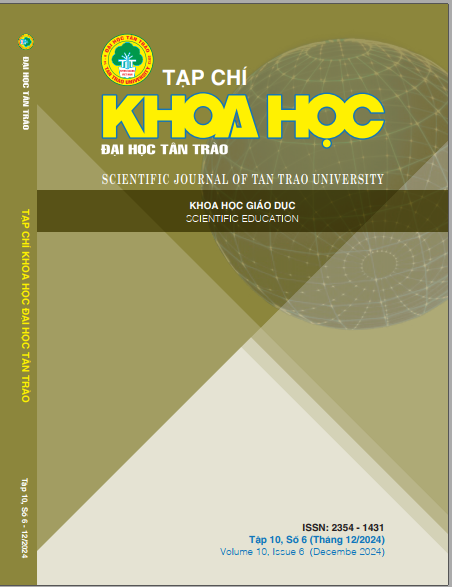ÁP DỤNG PHƯƠNG PHÁP TÍCH HỢP NỘI DUNG VÀ NGÔN NGỮ TRONG GIẢNG DẠY TIẾNG ANH PHÁP LÝ TẠI TRƯỜNG ĐẠI HỌC LUẬT HÀ NỘI
DOI:
https://doi.org/10.51453/2354-1431/2024/1285Từ khóa:
phương pháp tích hợp, Ngôn ngữ giảng dạy bằng tiếng Anh, thông ngữ, tiếng Anh chuyên ngành, tiếng Anh pháp lýTóm tắt
Phương pháp học tập tích hợp nội dung và ngôn ngữ là một phương pháp giảng dạy kết hợp giữa nội dung chuyên ngành và ngôn ngữ, và nó có vai trò rất quan trọng trong dạy tiếng Anh pháp lý. Phương pháp học tập tích hợp nội dung và ngôn ngữ giúp người học không chỉ nắm vững các thuật ngữ và cách diễn đạt trong lĩnh vực pháp lý mà còn nâng cao khả năng ngôn ngữ Anh thông qua tiếp xúc với các nội dung thực tế và tình huống pháp lý giả định. Phương pháp tích hợp này giúp người học thấy được cách ngôn ngữ Anh được sử dụng trong các văn bản pháp lý và trong giao tiếp pháp lý, tạo nên nền tảng vững chắc để làm việc hoặc học tập trong môi trường quốc tế. Bài viết sử dụng phương pháp phân tích tổng hợp nhằm lựa chọn mô hình phù hợp với đối tượng sinh viên theo học các học phần tiếng Anh pháp lý. Khi áp dụng mô hình 4 thành tố văn hoá, nội dung, nhận thức, và giao tiếp kết hợp với nhau trên nền tảng ngữ cảnh giao tiếp, người học phát huy được mục đích kép đó là học tiếng Anh chuyên ngành và kiến thức Luật học trong đó. Kết quả của nghiên cứu sẽ là nguồn tham khảo đối với nhà quản trị trường học trong việc hoạch đích chính sách áp dụng tiếng Anh trong giảng dạy, giảng viên đổi mới phương pháp và cách tiếp cận với kiến thức chuyên ngành, sinh viên cũng như nhà nghiên cứu có được thông tin hữu ích giúp họ không chỉ giỏi ngôn ngữ mà còn hiểu sâu về nội dung pháp lý, tăng khả năng hội nhập và làm việc trong môi trường quốc tế.Tải xuống
Tài liệu tham khảo
Coyle, D., Hood, P., & Marsh, D. (2010). CLIL: Content and Language Integrated Learning, Cambridge, Cambridge University Press.
Marsh, D. (2000). An introduction to CLIL for parents and young people. In D. Marsh, & G. Langé (eds.), Using Languages to Learn and Learning to Use Languages. Jyväskylä: University of Jyväskylä.
Zhou, X. (2022). CLIL in Higher Education Practical Classroom. A Case Study of Cross-Border E-commerce Course. Advances in Social Science, Education and Humanities Research, volume 670.
Nguyễn Thị Thu Hằng và Nguyễn Thị Mai Hoa. (2024). Giảng dạy tích hợp nội dung và Ngôn ngữ (CLIL) ở Việt Nam: Thách thức và giải pháp. Tạp chí nghiên cứu nước ngoài, tập 40, số 2. Truy cập từ trang: https://jfs.ulis.vnu.edu.vn/index.php/fs/article/view/5246/4501?lang=vi_VN
Chính phủ Việt Nam (2017). Quyết định số 2080/QĐ-TTg của Thủ tướng Chính phủ: Phê duyệt điều chỉnh, bổ sung Đề án dạy và học ngoại ngữ trong hệ thống giáo dục quốc dân giai đoạn 2017 - 2025. Truy cập từ trang: https://vanban.chinhphu.vn/default.aspx?pageid=27160&docid=192343
Nguyễn Thái Học (2019). Một số phương pháp dạy học tích cực áp dụng trong dạy học các môn mỹ thuật cơ sở tại Khoa Công nghệ thông tin Trường Cao đẳng nghề Bách Khoa Hà Nội. Nội san Trường Đại học Sư phạm Trung ương
Đỗ Thị Trinh, Trần Việt Cường, & Hoàng Văn Tài (2023). Một số biện pháp phát triển năng lực dạy học tích hợp cho sinh viên ngành sư phạm toán. Tạp chí Giáo dục, tập 23, số 4, trang 9-13.
Ngô Phan Anh Tuấn (2017). Đề xuất mô hình dạy học tích hợp trong giáo dục hướng nghiệp ở trường phổ thông. Tạp chí khoa học - Đại học Đồng Nai, số 04/2017, trang 1-10. https://dnpu.edu.vn/upload/elfinder/Tạp%20chí%20khoa%20h%E1%BB%8Dc/TCKH%20xuất%20bản/TCKH%20số%204/1.%20Ngo%20Phan%20Anh%20Tuan%201-10.pdf
Nguyễn An Giang (2024). Ảnh hưởng của phương pháp dạy học tích cực đối với hoạt động học tập của sinh viên Việt Nam. Tạp chí Thiết bị giáo dục: Nghiên cứu ứng dụng, tập 2, số 307.
Pigott, T. D. (2012). Advances in meta-analysis. New York, NY: Springer.
Tải xuống
Đã Xuất bản
Cách trích dẫn
Số
Chuyên mục
Giấy phép

Tác phẩm này được cấp phép theo Giấy phép Quốc tế Creative Commons Attribution-ShareAlike 4.0 .
Bài báo được xuất bản ở Tạp chí Khoa học Đại học Tân Trào được cấp phép theo giấy phép Ghi công - Chia sẻ tương tự 4.0 Quốc tế (CC BY-SA). Theo đó, các tác giả khác có thể sao chép, chuyển đổi hay phân phối lại các bài báo này với mục đích hợp pháp trên mọi phương tiện, với điều kiện họ trích dẫn tác giả, Tạp chí Khoa học Đại học Tân Trào và đường link đến bản quyền; nêu rõ các thay đổi đã thực hiện và các nghiên cứu đăng lại được tiến hành theo cùng một bản quyền.
Bản quyền bài báo thuộc về các tác giả, không hạn chế số lượng. Tạp chí Khoa học Tân Trào được cấp giấy phép không độc quyền để xuất bản bài báo với tư cách nhà xuất bản nguồn, kèm theo quyền thương mại để in các bài báo cung cấp cho các thư viện và cá nhân.
Mặc dù các điều khoản của giấy phép CC BY-SA không dành cho các tác giả (với tư cách là người giữ bản quyền của bài báo, họ không bị hạn chế về quyền hạn), khi gửi bài tới Tạp chí Khoa học Đại học Tân Trào, tác giả cần đáp ứng quyền của độc giả, và cần cấp quyền cho bên thứ 3 sử dụng bài báo của họ trong phạm vi của giấy phép.






